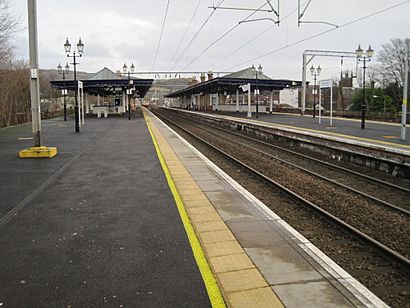Dumbarton Central railway station facts for kids
Quick facts for kids
|
|
|---|---|

View of Dumbarton Central station, looking east
|
|
| Location | Dumbarton, West Dunbartonshire Scotland |
| Coordinates | 55°56′47″N 4°34′02″W / 55.9465°N 4.5673°W |
| Owned by | Network Rail |
| Platforms | 3 |
| Other information | |
| Station code | DBC |
| Fare zone | D2 |
| History | |
| Original company | Lanarkshire and Dunbartonshire Railway & Caledonian and Dunbartonshire Junction Railway |
| Pre-grouping | Caledonian Railway & North British Railway |
| Post-grouping | LMS & LNER |
| Key dates | |
| 15 July 1850 | Opened |
| Traffic | |
| Passengers (2017/18) | |
| Passengers (2018/19) | |
| Passengers (2019/20) | |
| Passengers (2020/21) | |
| Passengers (2021/22) | |
|
Listed Building – Category A
|
|
| Designated | 31 January 1984 |
| Reference no. | LB24877 |
Dumbarton Central railway station is an important train station in the town of Dumbarton, Scotland. It's located in West Dunbartonshire. This station is a key stop on two main train lines: the West Highland Line and the North Clyde Line. It is about 15.75 miles (25.35 km) northwest of Glasgow Queen Street station.
Contents
Station History
Early Days and Connections
Dumbarton Central station first opened its doors on 15 July 1850. It was built by a company called the Caledonian and Dumbartonshire Junction Railway. The original train route went from Balloch Pier to Bowling. From Bowling, people could take steamships on the River Clyde to reach Glasgow.
By 1858, the station became part of a longer route. This connected Glasgow Queen Street to Helensburgh Central. This happened through connections with the Glasgow, Dumbarton and Helensburgh Railway.
Growing Networks
Over time, the railway company that owned Dumbarton Central changed. In 1862, it joined the Edinburgh and Glasgow Railway. Three years later, it became part of the larger North British Railway.
Later, in 1891, the North British Railway made an agreement with a rival company, the Caledonian Railway. This allowed the Caledonian Railway to use the tracks to get to Balloch. This was important because Balloch had steamships on Loch Lomond. This agreement stopped the Caledonian Railway from building its own competing line.
Because of this, the Lanarkshire and Dunbartonshire Railway arrived at Dumbarton Central in 1896. Also, trains from the West Highland Railway started stopping here on 1 August 1894. These trains still use the station today.
Station Design and Changes
The station was built with two special "island platforms." These are platforms with train tracks on both sides. This design made it easy for passengers to switch between different train services. Today, only three of these platform sides are still used.
In the 1960s, British Railways made the Helensburgh and Balloch lines electric. This was part of the North Clyde Line electrification plan. However, some parts of the railway were closed down. This happened on 5 October 1964, due to a plan called the Beeching Axe. This plan closed many railway lines across the UK. As of 2022, one of the loop platforms on the south side of the station is not used for regular trains.
Building Features
Dumbarton Central station is a very important building. It is a "Category A listed building" under Scottish law. This means it has special historical or architectural importance. It is protected to make sure it stays preserved for the future.
How Many People Use the Station?
Many people use Dumbarton Central station every year. Here's a quick look at how many passengers used it recently:
| 2019-20 | 2020-21 | 2021-22 | |
|---|---|---|---|
| Entries and exits | 718,088 | 75,242 | 309,658 |
| Interchanges | 102,905 | 8,003 | 53,273 |
These numbers cover twelve-month periods starting in April each year.
Train Services
Dumbarton Central is a busy station with many trains.
North Clyde Line and Argyle Line
From Monday to Saturday, six trains per hour travel southeast towards Glasgow Queen Street and beyond.
- Two trains per hour go directly to Edinburgh. These trains make fewer stops.
- Two trains per hour go to Springburn and Cumbernauld via Yoker.
- Two trains per hour go via Singer to Airdrie.
On Sundays, trains go via Singer to Edinburgh Waverley. Other trains go via Yoker, alternating between Motherwell (via Whifflet) and Larkhall.
Trains going northwest from Dumbarton Central run twice an hour to Balloch. Another two trains per hour go to Helensburgh Central. The other two trains per hour end their journey here at Dumbarton Central.
West Highland Line
Trains on the West Highland Line also stop at Dumbarton Central.
- Six trains per day on weekdays go towards Oban. On Sundays, there are three trains.
- Three trains per day on weekdays go to Fort William and Mallaig. On Sundays, there is one or two trains, depending on the time of year.
Caledonian Sleeper
The Highland Sleeper train also stops here every day. It does not stop on Saturday nights (southbound) or Sunday mornings (northbound). This special train gives the station a direct link to and from London Euston. It travels via Edinburgh, Crewe, and the West Coast Main Line.
| Preceding station | Following station | |||
|---|---|---|---|---|
| Dalmuir | ScotRail West Highland Line |
Helensburgh Upper | ||
| Dalmuir | Caledonian Sleeper Highland Caledonian Sleeper |
Helenslnk | ||
| Dumbarton East | ScotRail North Clyde Line |
Dalreoch | ||
| Historical railways | ||||
| Dumbarton East Line and Station open |
Caledonian Lanarkshire and Dunbartonshire Railway |
Terminus | ||
| Bowling Line closed; Station open |
Caledonian & North British Railway Caledonian and Dunbartonshire Junction Railway |
Dalreoch Line and Station open |
||

